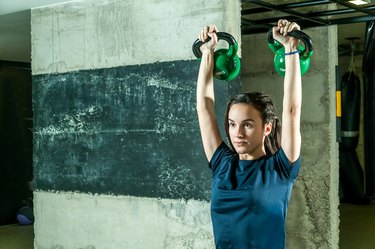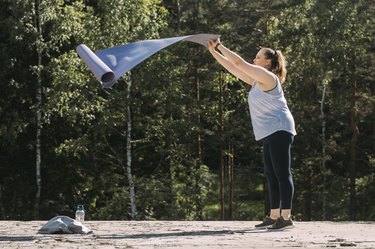

If you're new to lifting weights, picking up your first dumbbells, kettlebells and barbells can be a daunting task — especially if you're living with obesity. After all, in the past, the weight room hasn't been the most welcoming to all body types (and it still has a ways to go, frankly).
But here's the first thing you should know about strength training with obesity: It's not really that different from strength training with any other body type, says New York-based certified personal trainer Morit Summers, CPT.
Video of the Day
Video of the Day
"Everyone is very different. They have different strengths and weaknesses," she says. "They have bodies that move in different ways. Generally speaking, strength is strength, and movements are movements, but each person needs to learn how to move for their own bodies."
And regardless of your body type, training with a plan that's specific to your body can help you get the greatest mental and physical benefits from your sessions, Summers says.
Read on to learn the best strength-training exercises you can do, how to structure your workouts and how to get the most from every rep.
1. Master Foundational Compound Exercises
Many of the strength-training exercises recommended for people with obesity are the same moves recommended across body types, Summers says. So you'll want to prioritize compound movements — exercises that move multiple joints and muscle groups at once, says Noam Tamir, CSCS, a certified strength and conditioning specialist and founder of TS Fitness.
Compound movements train your body to carry out everyday tasks, such as squatting, lunging, pulling (rows), pushing (push-ups), hinging (deadlifts) and rotating, which make them highly functional. This makes them more beneficial compared with isolation exercises that focus only on one muscle group at a time.
Related Reading
2. Test Different Variations
Everyone's body moves differently, so while the standard way of doing a certain exercise may feel comfortable for one person, it may not be ideal for another. That's why tweaking exercises for your body is so helpful. After all, exercises should work for your body, not against it.
"A squat is a squat, [for instance]. It just has to be adjusted based on the person's ability and body," Summers says. "Every single exercise has a progression and regression and hundreds of different variations in-between. Every single beginner or advanced lifter has a different ability."
A little trial and error is probably necessary here. For people with more narrow hips, taking a wide stance during squats may feel more comfortable, according to Lore McSpadden-Walker, CPT, a certified inclusive fitness trainer and co-founder of Positive Force Movement. This can give your midsection a little more space.
For those who struggle with push-ups, swap for a move that works the same muscles but offers some more accessibility, like a floating tabletop.
Bottom line: Exploring different exercise variations is just another way to make exercise feel more comfortable (and enjoyable) for your body.
Related Reading
3. Start With 2 to 3 Days Per Week
Aim to strength train 30 to 40 minutes per day, two or three days each week, Tamir recommends.
As you get stronger and fitter, progress to a maximum of five days of strength training per week to allow for some recovery (more on that below), says Samuel Becourtney, DPT, a physical therapist at Bespoke Treatments in New York City.
If you're training, in general, three days or less in one week, stick to total-body workouts each strength day, Becourtney says. "This will allow you to hit every muscle group more than once in the week."
As you become more advanced with four strength days per week, split your sessions into two upper-body and two lower-body workouts, alternating between the two, he says. Then, when you get to five days, you can specify down to the individual muscle group.
4. Use RPE to Guide Reps and Sets
Ideally, you want to do 3 to 5 sets of 6 to 12 reps per exercise. However, this will largely vary depending on the exercises you're doing and the intensity of the moves.
That's why Tamir suggests that you exercise according to your rate of perceived exertion (RPE). Measure your effort from 1 to 10, where 1 is little to no effort and 10 is all-out intensity.
Throughout the workout, beginners should shoot for an RPE of 5 to 6, prioritizing exercise form, rather than the overall intensity. As you get more experienced, an RPE of 7 to 8 is a good level to maintain.
When it comes resistance, choose a pair of dumbbells that feel comfortably challenging, he says. You should be able to do a majority of your reps pretty easily, with a good, but doable, challenge toward the end of your set.
Between sets, constantly check in with your body, analyzing your fatigue and effort levels, particularly in the beginning weeks of strength training. Over time, you'll develop a better understanding of your body's abilities and you'll be more comfortable programming sets and reps for different moves.
5. Add Resistance Over Time
Constantly increasing your overall training volume (your sets x reps x weight) is the key to making progress with strength training — aka progressive overload — especially when an exercise at a given weight becomes too easy. In order to continue building strength, you need to consistently increase your training volume over time, according to the National Academy of Sports Medicine.
The best way to do this is by keeping note of your exercises, the weight you're lifting and the sets and reps you're performing. Try to increase the weight, sets or reps of your exercises each week in small increments (even just 5 pounds or 2 reps).
And when you can move through all your sets and reps with ease, swap in new exercises or variations once that time period is up. For body-weight exercises, try a progression or a new variation before tacking on external load.
"I typically like to mix up exercises every one to two months," Becourtney says. "Some people may get bored and switch up exercises every week, however, your muscles adapt to a repeated and specific stimulus over multiple consecutive weeks."
Ready to Overload but Can't Go Up in Weight?
Sometimes, you might find that a given weight is too light, but the next one up is too heavy. If that's the case, try doing more reps or slowing down the eccentric (lowering) portion of the exercise until you're ready for a heavier weight.
6. Warm Up and Cool Down
All of your training sessions should always include a warm-up and cooldown, Tamir says. Start each workout with a short brisk walk (think 5 to 10 minutes), followed by some dynamic warm-up exercises like glute bridges or cat-cows.
Wrap up each workout with a cooldown stretch routine, breathing into the muscles with each stretch. These parts of your workout are important for preventing muscle soreness and injury down the line, according to Becourtney.
"Someone living with obesity may feel stiffer, as they put more stress on their joints on a day-to-day basis, so they may require additional time to warm up the joints and get the blood flowing to the muscles," he says. "Similarly, they may need a little extra cooldown time.
7. Recover
Your recovery days are just as important as your strength-training days. Ideally, you'll want to get in at least one to two full rest days each week to allow your body to recover properly, Becourtney recommends.
It's also best to take 48 to 72 hours of recovery between strength-training sessions, according to Tamir. Between these strength workouts, take a day of total rest, followed by a day or two of cardio and active recovery.
On your rest days, avoid any strenuous exercise and focus on activities that promote recovery, including foam rolling and stretching, Tamir says.
Your active recovery days can also help you meet your weekly cardio goal, especially if you're getting in some walking, moderate hiking or restorative yoga.
- American Council on Exercise: "5 Benefits of Compound Exercises"
- Occupational Medicine: "The Borg Rating of Perceived Exertion (RPE) Scale"
- National Academy of Sports Medicine: "Back to the Basics: Hypertrophy"
- Centers for Disease Control and Prevention: "How Much Physical Activity do Adults Need?"
- Journal of Obesity: "Evidence for Resistance Training as a Treatment Therapy in Obesity"
- American Journal of Medical Science: "Safety, feasibility, and Efficacy of a Resistance Training Program in Preadolescent Obese Children"



